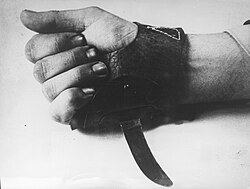| Revision as of 03:55, 30 January 2008 view sourceGriffinSB (talk | contribs)Extended confirmed users1,787 edits Undid revision 187849165 by 24.193.112.80 (talk)← Previous edit | Revision as of 18:16, 30 January 2008 view source Big Bird (talk | contribs)Autopatrolled, Extended confirmed users, Pending changes reviewers, Rollbackers19,576 edits →External Links: removed comments that belong on the talk pageNext edit → | ||
| Line 28: | Line 28: | ||
| * | * | ||
| * |
* | ||
| *http://www.un.org/icty/transe9/021206ED.htm | *http://www.un.org/icty/transe9/021206ED.htm | ||
| Line 34: | Line 34: | ||
| *http://www.un.org/icty/transe11/060912IT.htm | *http://www.un.org/icty/transe11/060912IT.htm | ||
| * |
* | ||
| ==References== | ==References== | ||
Revision as of 18:16, 30 January 2008
| The neutrality of this article is disputed. Relevant discussion may be found on the talk page. Please do not remove this message until conditions to do so are met. (Learn how and when to remove this message) |

Srbosjek (literally serb-cutter in Croatian, often mentioned as cutthroat) was an especially designed knife, used mostly for speedy slaughter of Serbs and other victims by the Croatian Ustaše fascists during the WW2 in the Independent State of Croatia, an Axis puppet state.
This knife was manufactured during WW2 by German factory Gebrüder Gräfrath from Solingen-Widderit (which is still in existence today, albeit under another name) under a special order from the NDH government, and was used for slaughter of Serbs, Jews and other victims in organized mass murders at the concentration camp Jasenovac and other places.
The upper part of serb cutter is made of leather, as a sort of a glove, designed to be worn so that the thumb goes through the hole up there, and so that only the blade protrudes from the hand. There was inscription "Gräwiso" on the leather part of the knife, and it was sometimes called "graviso knife" because of this. The blade is curved in order to make it easier to slit the throat of the victim, following the curvature of the neck.
The srbosjek knife was allegedly designed after Ante Pavelic held a session of his NDH government, where one of the items on the agenda was what kind of a knife should be designed to make it possible for the executioners to kill people as fast as possible and with as little fatigue as possible.
In Jasenovac concentration camp once a competition in speedy slaughter was organised by the Ustasha camp guards. The winner of this competition, Petar Brzica allegedly cut the throats of 1360 prisoners and won the competition.
Accuracy of the sources
| This section possibly contains original research. Please improve it by verifying the claims made and adding inline citations. Statements consisting only of original research should be removed. (December 2007) (Learn how and when to remove this message) |
The accuracy of the sources mentioning the Srbosjek is disputed. As of now those are serbian sources describing war crimes commited by their war time opponent, the Croats. Even as the Jasenovac camp is a part of the Holocaust, which is internationally rather well documented, there are practically no third party sources describing the knife. There also have not been found any croatian reference to Srbosjek, even though the word itself is allegedly croatian, and the place where the crimes happened and where the knife has allegedly been used lies in present time Croatia.
External Links
References
- Jasenovački logor smrti, dr Nikola Nikolić, 1948
- ^ Takozvana NDH, dr Mladen Colic, Deltapres, Beograd 1973
- Vatikan i Jasenovac, Vladimir Dedijer, Dokumenti (Beograd: “Rad”, 1987)
- Wanted ! : The Search for Nazis in America, Howard Blum, Quadrangle/New York Times Book Co. 1977